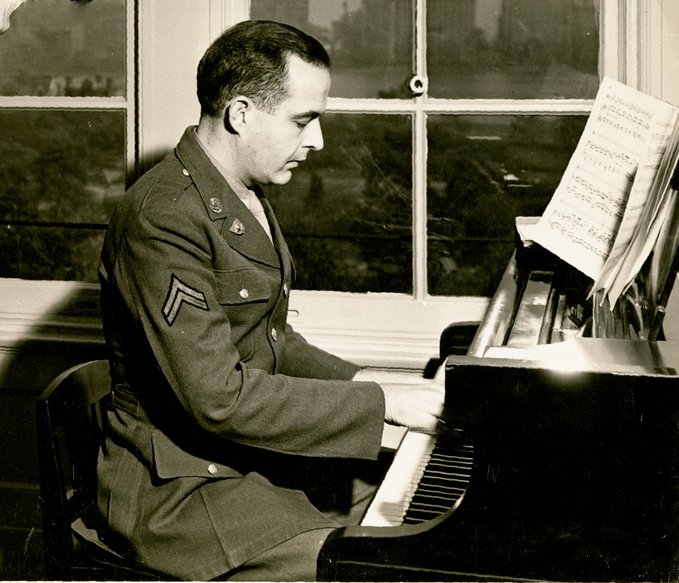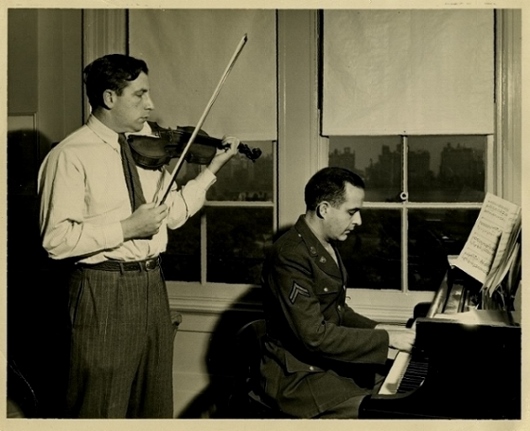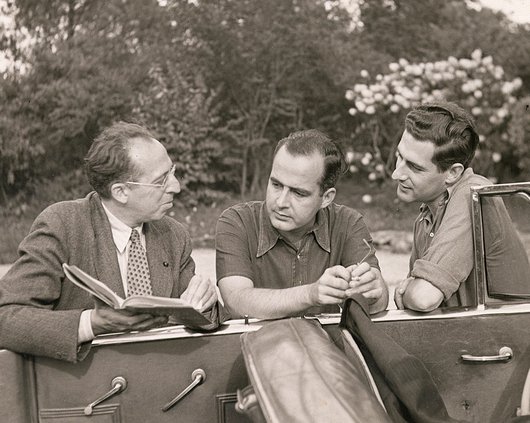Samuel Barber Complete Thematic Catalogue - Sibelius SCORCH files for Chapter 4. Maturity, The War and Post-War Years.
Barber's score incipits for all the works composed in his thirties. Samuel Barber: A Thematic Catalogue of the Complete Works by Barbara B. Heyman, published by Oxford University Press; in the volume, all excerpts from the published and unpublished works of Samuel Barber are reprinted by permission of G. Schirmer, Inc., and the Samuel Barber Trust. Sibelius SCORCH files for Chapter 4: Works 1940-1949 (H-95 to H-117). This section includes the pieces Samuel Barber wrote in the war and post-war years, among which the Capricorn Concerto Op. 21, the Concerto for Violoncello and Orchestra Op. 22, and the Piano Sonata Op. 26.

View and listen to the score incipits and relevant Sibelius SCORCH audio files of Samuel Barber’s Thematic Catalogue. The Table of Contents and the Index Numbers refer to Samuel Barber: A Thematic Catalogue of the Complete Works by Barbara B. Heyman (Oxford University Press, 2012). This online publication is an innovative ICAMus project carried out by special arrangement with Dr. Heyman and with the Publisher. Barbara Heyman is the author of Samuel Barber: The Composer and His Music (Oxford University Press, 1992).
* Note. If you are unable to view the Sibelius SCORCH files, please install the plug-in here. It is free and easy. The plug-in allows you to view and listen to the score incipits of Samuel Barber’s Thematic Catalogue, inclusive of all his early, rare, unpublished and incomplete compositions. The Sibelius score incipit for each work follows the title it refers to.
SAMUEL BARBER (1910-1981)
REGISTER OF INCIPITS
PART 4 (1940-1949) H-95 to H-117
H-95 A Stopwatch and An Ordnance Map, Op. 15. Text by Stephen Spender (1909-1995). For full chorus of men's voices (tenors 1 & 2, basses 1 & 2) and 3 kettledrums,with optional instrumental accompaniment; 1939-1940.
H-96 Ave Maria. Transcription from setting by Josquin de Près. For mixed chorus SATB; transcribed in 1940.
H-97 Song for a New House. Text by William Shakespeare (1564-1616), A Midsummer Night's Dream. For medium voice, flute and piano, with Ad Libitum cadenza; 1940.
Allegro molto— Andante con moto
Allegro giocoso; Andante sostenuto — Coda: Allegro
H-98 Commemorative March. For violin, cello and piano; 1940.
H-99 Reincarnations, Op. 16. Text by James Stephens (1882-1950). For four-part unaccompanied chorus SATB; 1936-1940.
a. Mary Hynes, Op. 16, No. 1
b. Anthony O Daly, Op. 16, No 2
c. The Coolin, Op. 16, No. 3
H-100 Between Dark and Dark. Text by Katherine Garrison Chapin (1890-1977). Song for voice and piano; 1942. Location unknown.
H-101 Second Essay, Op. 17. For orchestra; 1942.
Opening
Fugue
Più tranquillo
H-102 Who Carries Corn and Crown. Text by Robert Horan (1922-1981). Song for voice and piano; ca. 1942.
H-103 Two Songs, Op. 18. For medium voice and piano; 1942-1943.
a. The Queen’s Face on the Summery Coin, Op. 18, No. 1. Text by Robert Horan (1922-1981).
b. Monks and Raisins, Op. 18, No. 2. Text by José García Villa (1914-1997).
H-103b-arr Monks and Raisins, Op. 18, No. 2. Text by José García Villa (1914-1997). Transcription for voice and orchestra. Transcribed ca. 1943-1944.
H-104 Funeral March (based on the Army Air Corps Song). For band; 1943.
H-104arr Funeral March (based on the Army Air Corps Song). Arranged for concert orchestra; date unknown.
H-105 Commando March. For band or orchestra; 1943.
H-106 Ad Bibinem cum me rogaret ad cenam. Text adapted from Venantius Fortunatus (ca. 530-ca. 600/609) trans. by Helen Waddell. For unaccompanied mixed chorus SATB.
H-107 Second Symphony (“Flight Symphony”), Op. 19. For orchestra; 1943-1944.
I. Allegro ma non troppo
II. Andante, un poco mosso
III. Presto, senza battuta — poco sostenuto — a tempo
H-107arr Night Flight, Op. 19a. Orchestral tone poem based on the Second Movement (Andante, un poco mosso) of the Second Symphony (“Flight Symphony”), Op. 19; 1963.
H-108 Excursions, Op. 20. For piano; 1942-1944.
I. Un poco allegro
II. In slow blues tempo
III. Allegretto
IV. Allegro molto
H-109 Capricorn Concerto, Op. 21. For flute, oboe, trumpet and strings; 1944.
I. Allegro ma non troppo
II. Allegretto
III. Allegro con brio
H-110 Long Live Louise and Sidney Homer. Three-part vocal canon. For three women's voices; 1944.
H-111 Horizon. For orchestra; 1945.
H-112 Concerto for Violoncello and Orchestra, Op. 22. 1945.
I. Allegro moderato
II. Andante sostenuto
III. Molto allegro ed appassionato — a tempo
H-113 Cave of the Heart (Medea; Ballet, orig. Serpent Heart). For chamber orchestra; 1945-1946.
I. Maestoso
II. Allegretto
III. [no tempo marking]
IV. Allegro ma non troppo, giocoso
V. Andante sostenuto
VI. Moderato
VII. Sombre, with dignity
VIII. Minaccioso (with foreboding)
IX. Allegro molto
H-113arr Medea, Op. 23, Orchestral Suite from the Ballet Cave of the Heart. 1947.
I. Parodos
II. Choros. Medea and Jason
III. The Young Princess. Jason: Allegro ma non troppo, giocoso
IV. Choros: Moderato
V. Medea: Sombre, with dignity
VI. Kantikos Agonias: Minaccioso, with foreboding
VII Exodos: Allegro; at m. 4 più mosso
H-114 Knoxville: Summer of 1915, Op. 24. Text by James Agee (1909-1955). For soprano and chamber orchestra (originally for mezzo soprano and orchestra); 1947, rev. 1950.
H-115 Nuvoletta, Op. 25. Text from James Joyce (1882-1941), Finnegans Wake. Song for voice and piano; 1947.
H-116 String Quartet in E Major, II. Incomplete; 1948-1950.
H-117 Sonata for Piano, Op. 26. 1947-1949.
I. Allegro energico
II. Allegro vivace e leggero
III. Adagio mesto
IV. Fuga— Allegro con spirito

SAMUEL BARBER - THEMATIC CATALOGUE INDEX:
PART 1
Samuel Barber Complete Thematic Catalogue - Sibelius SCORCH files for Chapter 1. Childhood.
Earliest Works, 1917-1923 (H-1 to H-19). This section includes the first compositions Samuel Barber wrote as a child.
PART 2
Samuel Barber Complete Thematic Catalogue - Sibelius SCORCH files for Chapter 2. Adolescence.
Works 1924-1929 (H-20 to H-58). This section includes the compositions Samuel Barber wrote as a teenager.
PART 3
Earliest Works, 1930-1939 (H-59 to H-94). This section includes the pieces Samuel Barber wrote in his youth.
PART 4
Works 1940-1949 (H-95 to H-117). This section includes the pieces Samuel Barber wrote in his thirties, among which the Capricorn Concerto Op. 21, the Concerto for Violoncello and Orchestra Op. 22, and the Piano Sonata Op. 26.
PART 5
Works 1950-1959 (H-118 to H-129). This section includes the pieces Samuel Barber wrote in his more mature years, among which Hermit Songs Op. 29, and the opera Vanessa, to a libretto by Gian Carlo Menotti.
PART 6
Works 1960-1969 (H-130 to H-139). This section includes the pieces Samuel Barber wrote over a decade, among which the Piano Concerto Op. 38, and the opera Antony and Cleopatra, to a libretto adapted from Shakespeare by Franco Zeffirelli.
PART 7
Samuel Barber Complete Catalogue - Sibelius SCORCH files for Chapter 7. 1970-1981: The Last Years.
Works 1970-1981 (H-140 to H-146). This section includes the last pieces that Barber completed, among which the Ballade for piano and the Third Essay for Orchestra.
PART 8
Samuel Barber Complete Catalogue - Sibelius SCORCH files for Chapter 8. Unidentified Fragments.
Unidentified Manuscripts (H-U1 to H-U8). This section includes holograph sketches and fragments from different time periods of the composer's career.
Please note: All of our Barber website pages include a direct link to install the plug-in for viewing and playing the music incipits. Plug-in installation is free and very easy. Installation and fruition of Sibelius Scorch may feature differently on different operating systems and browsers, and various versions of them. For system requirements and full compatibility information, please read this.


